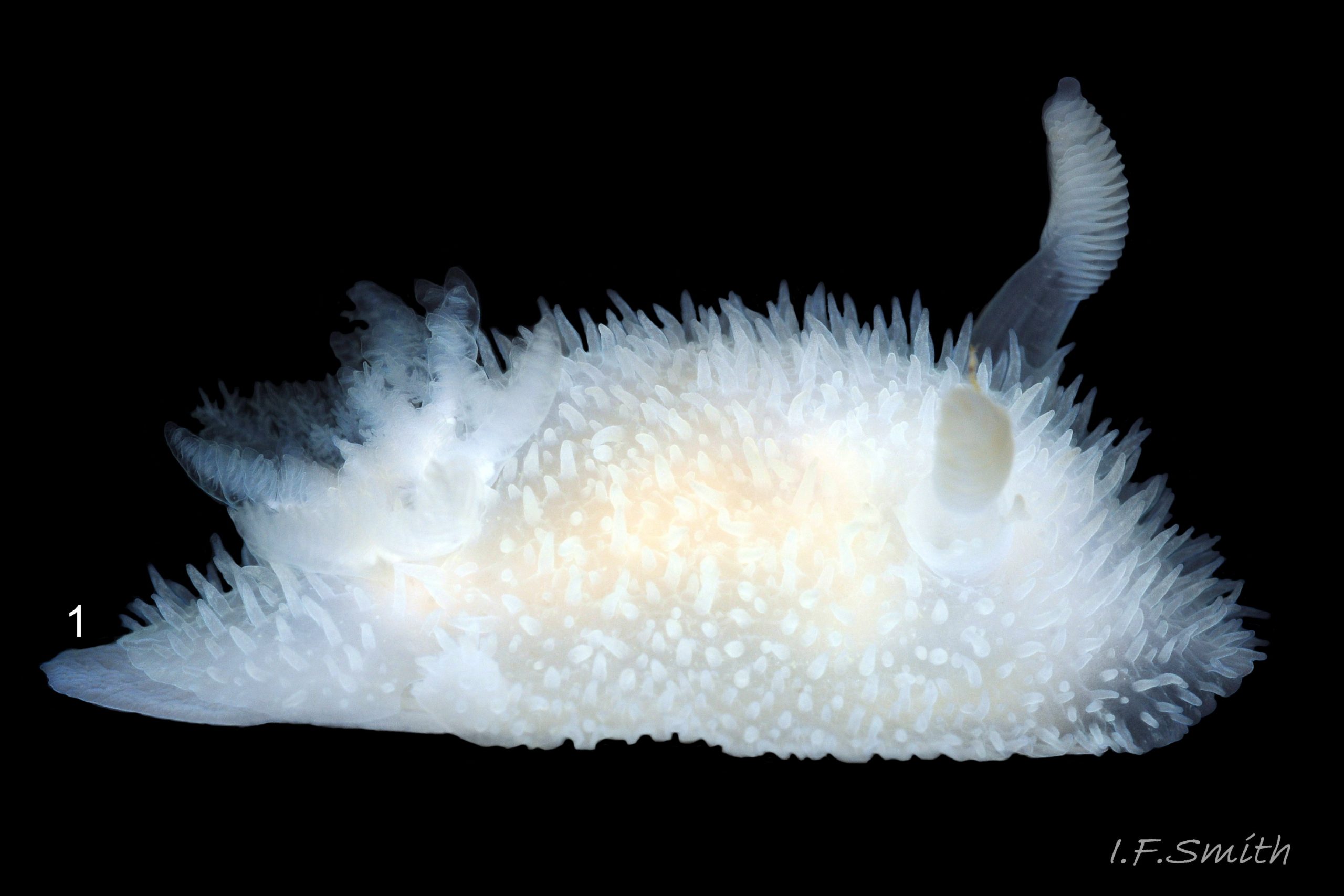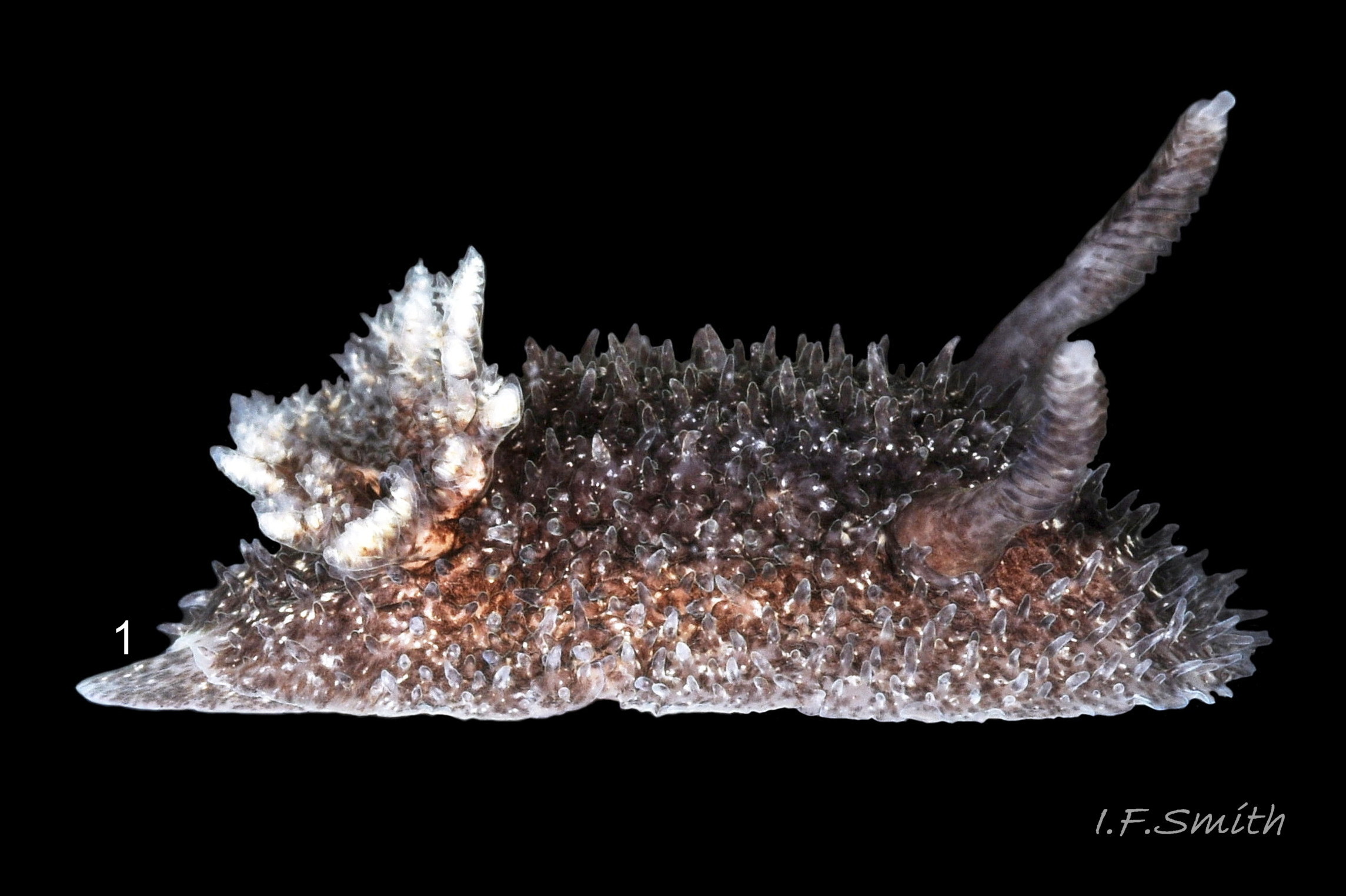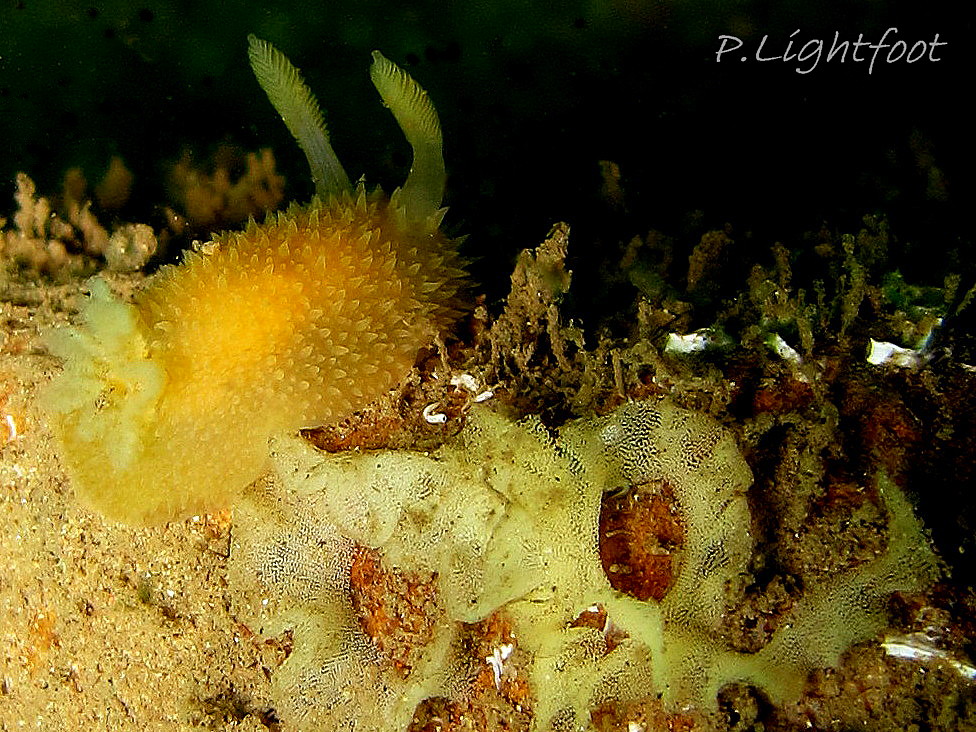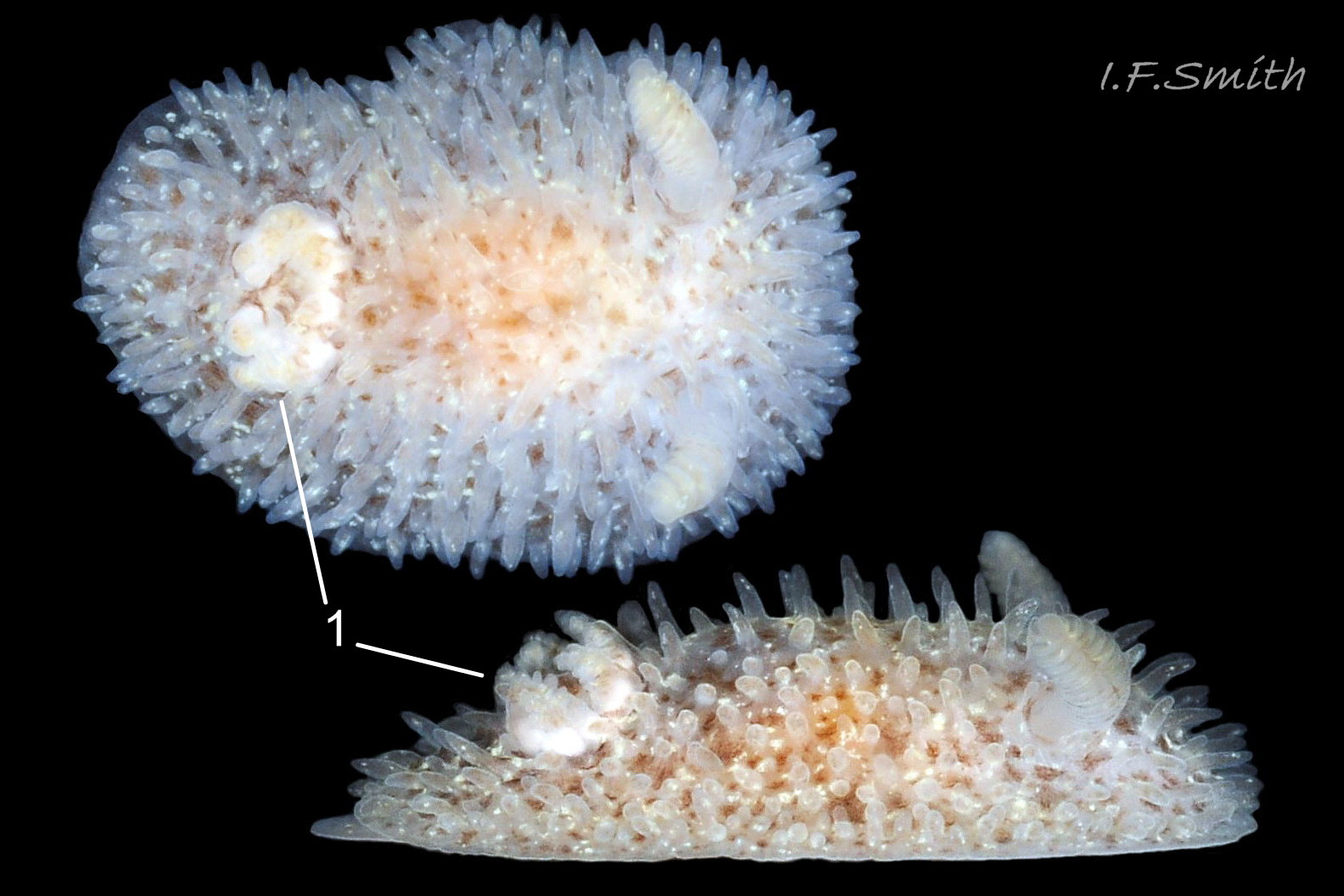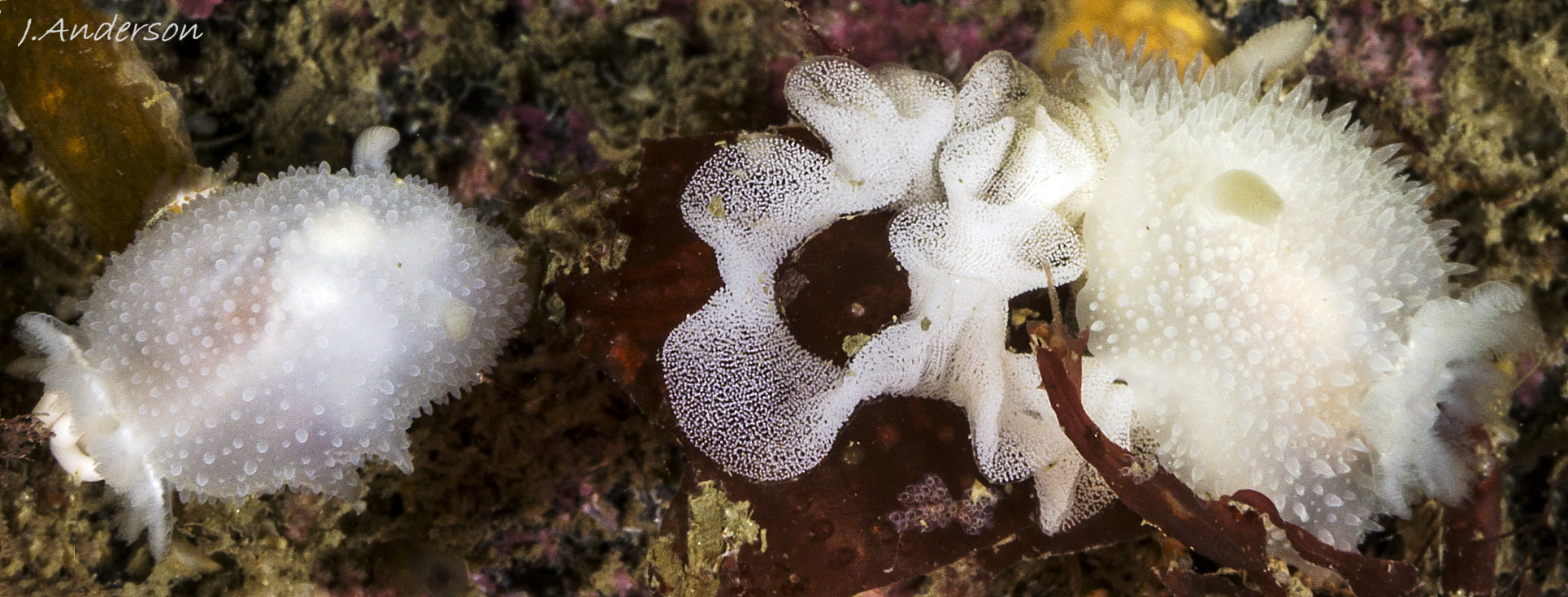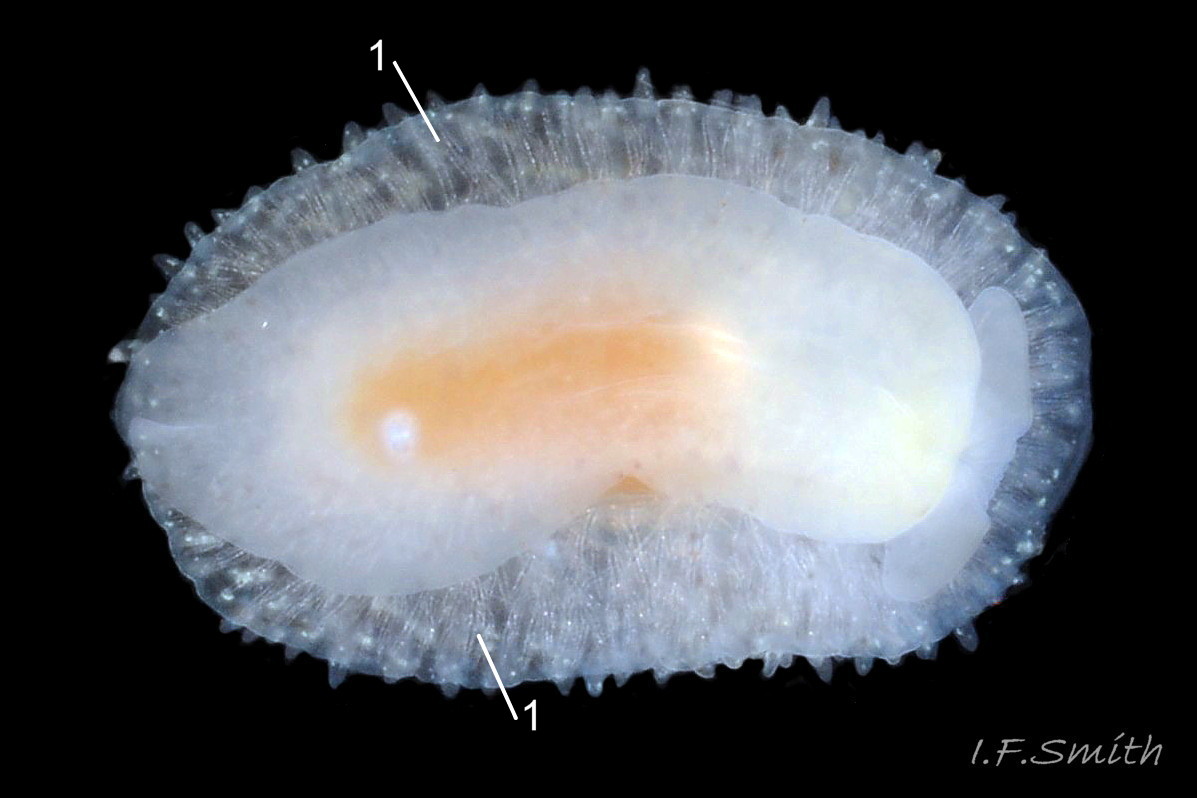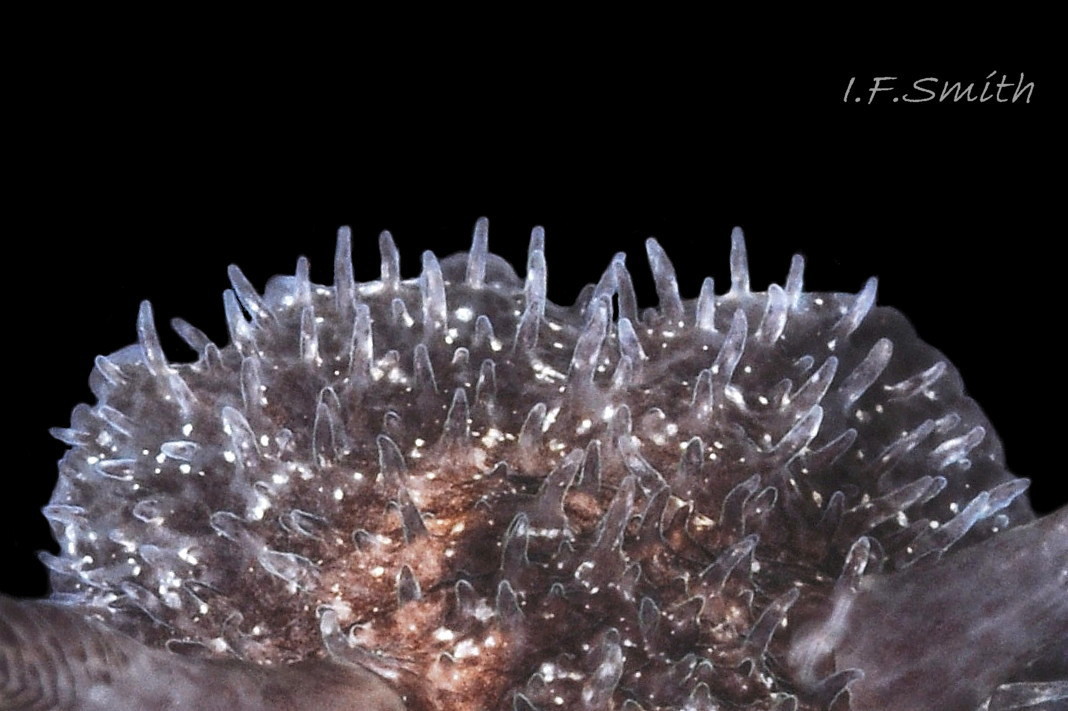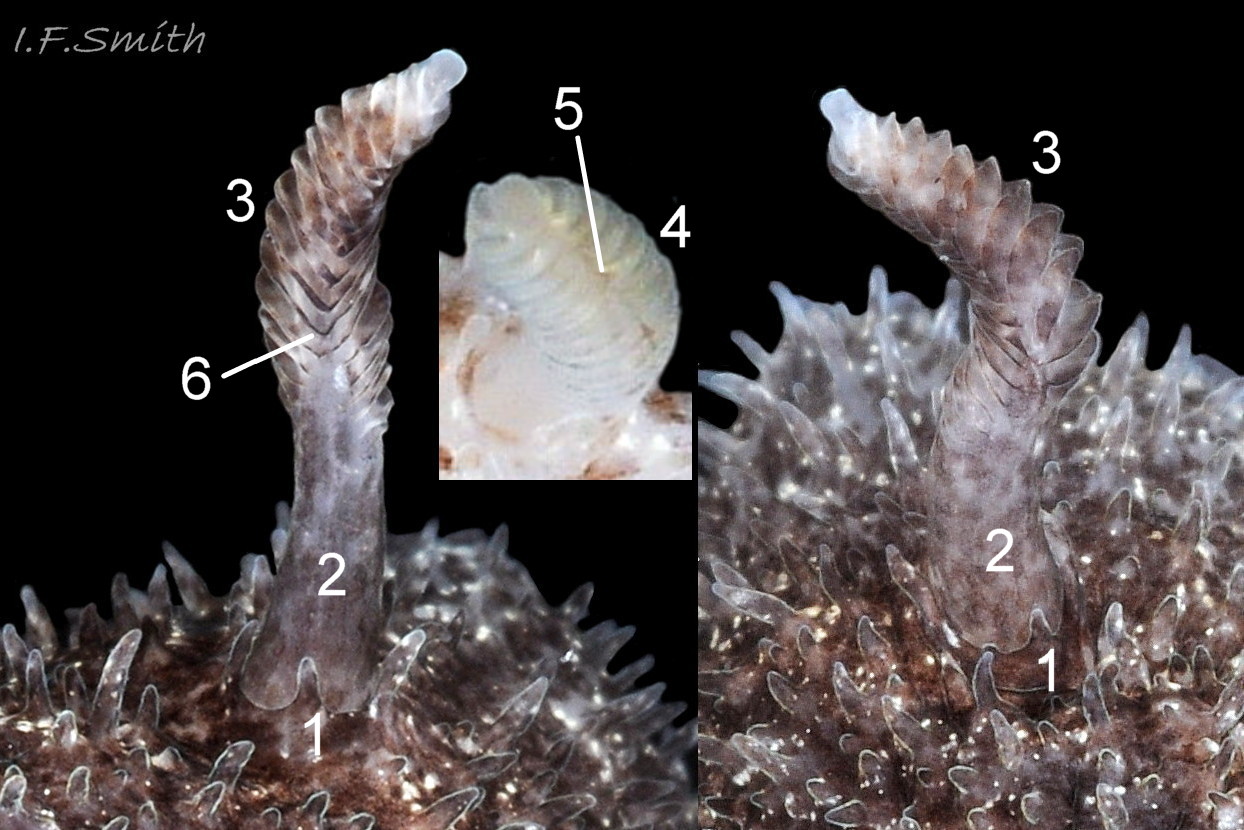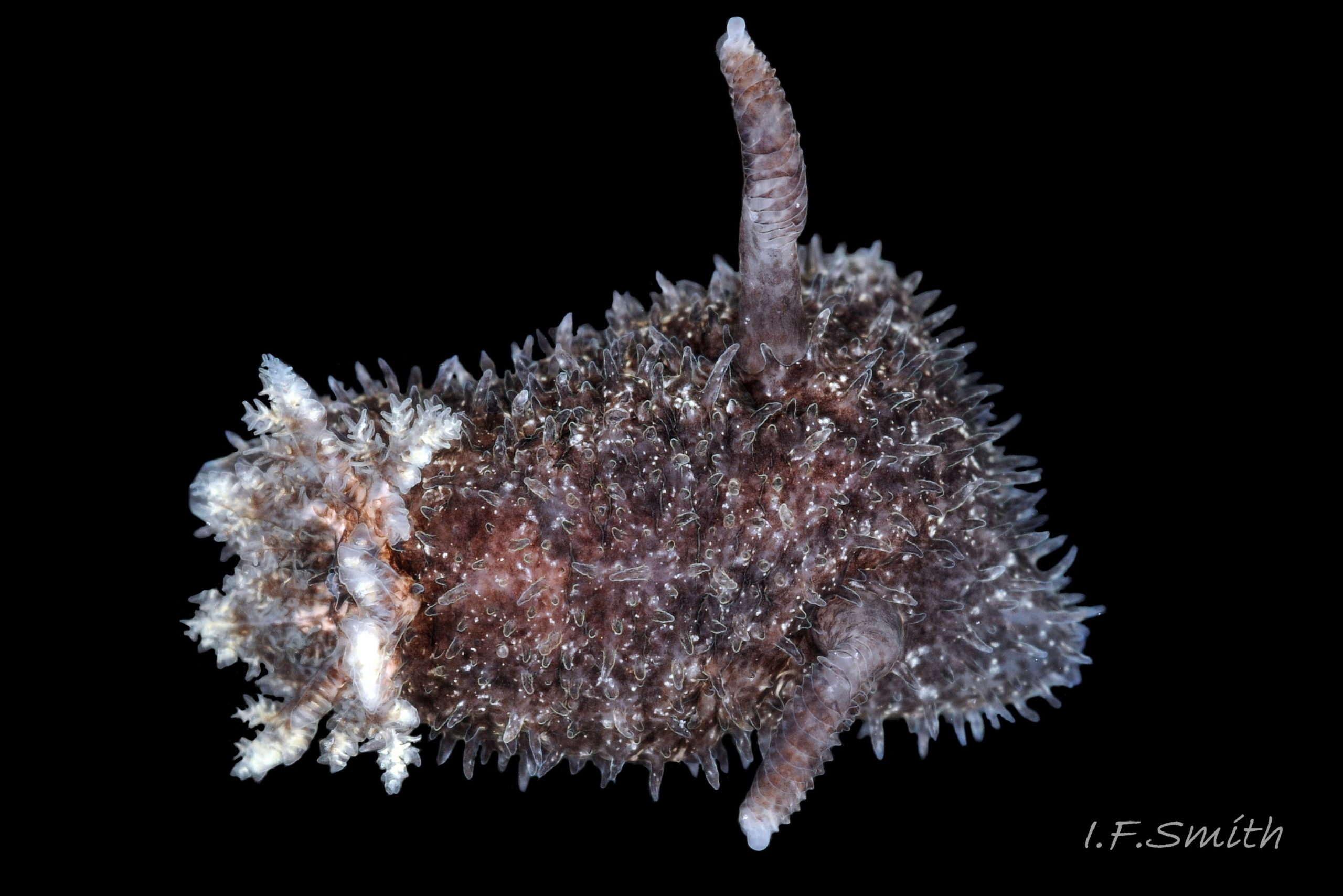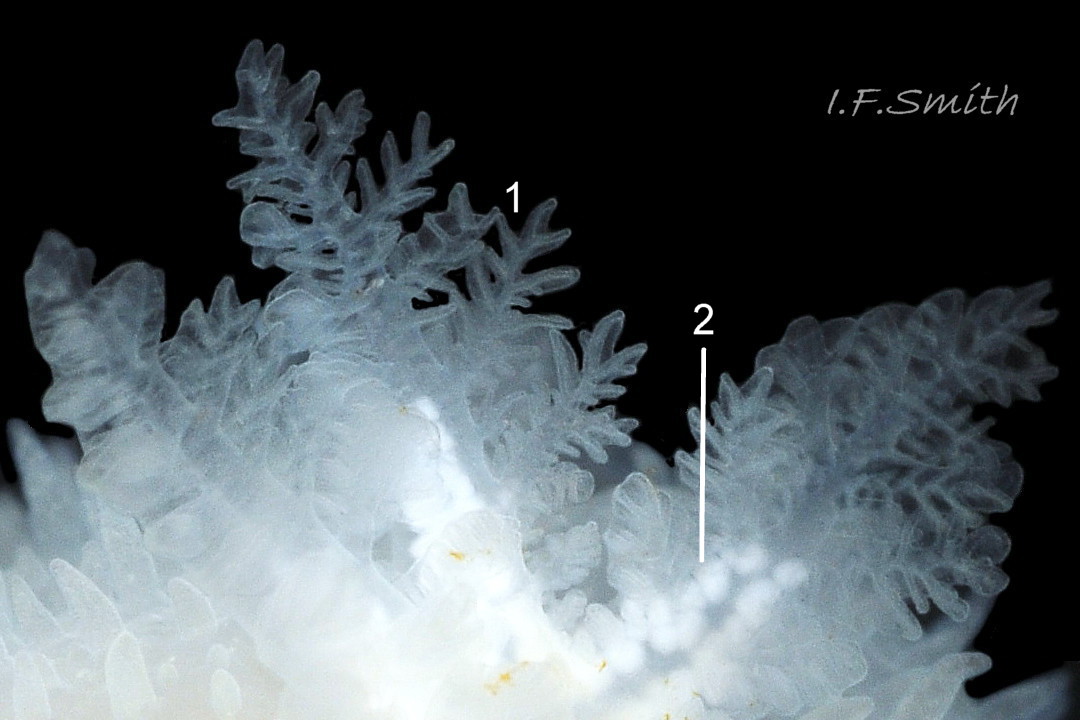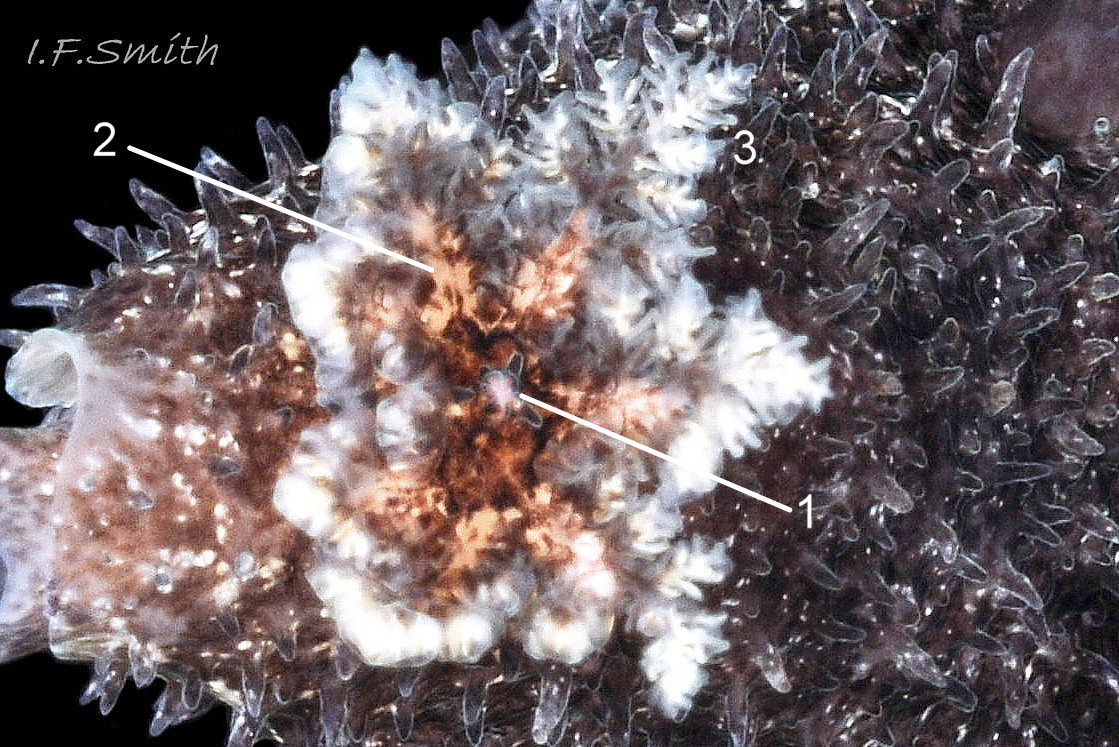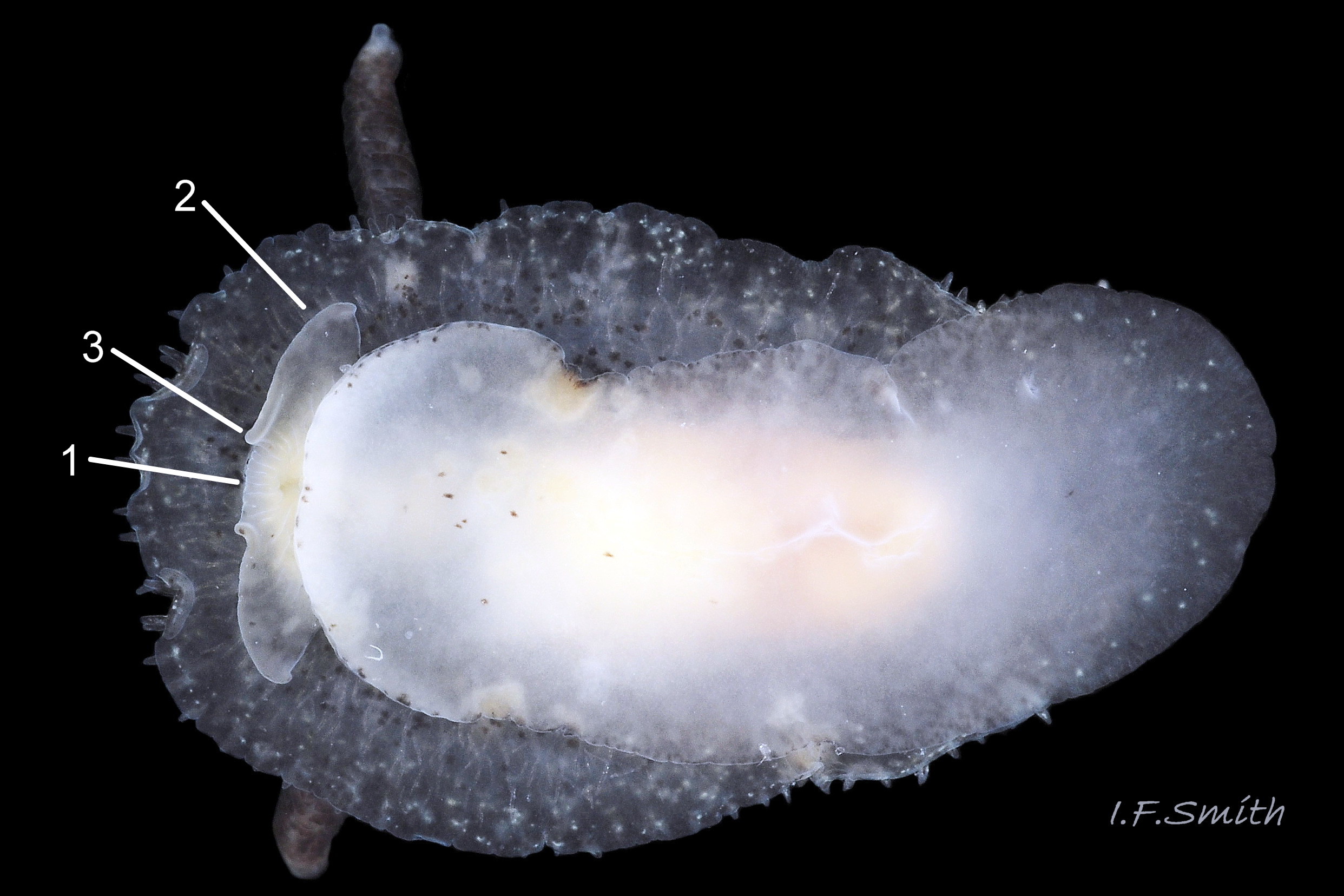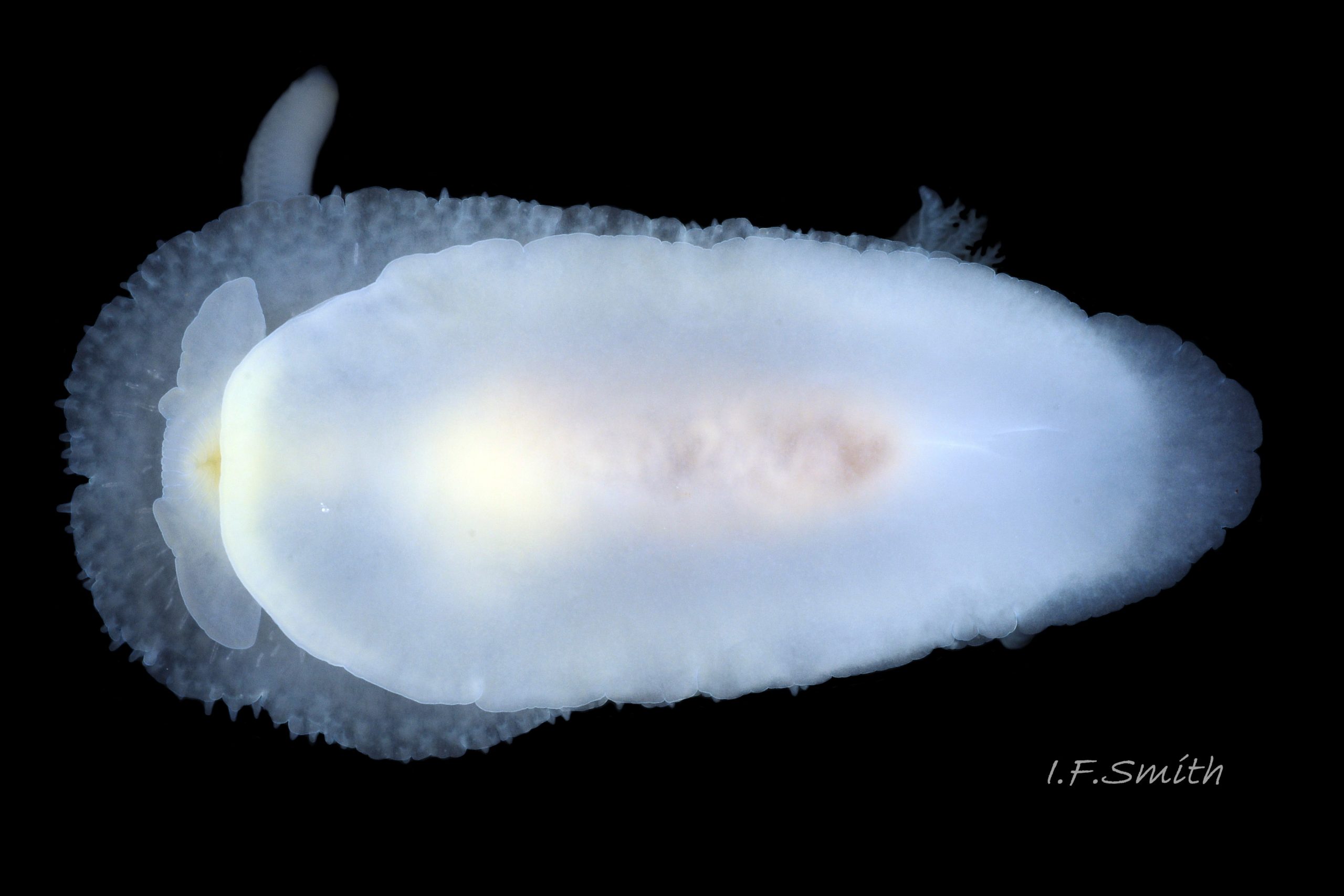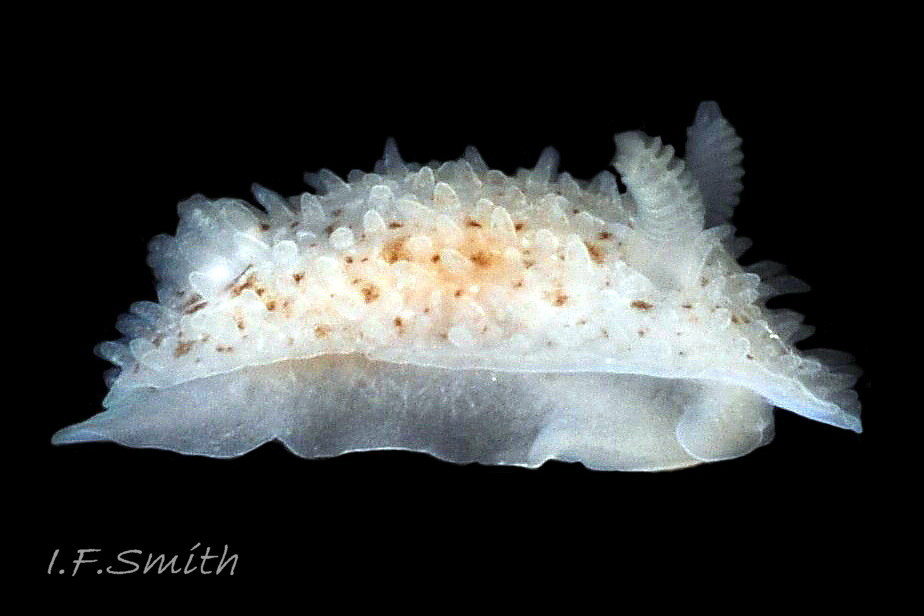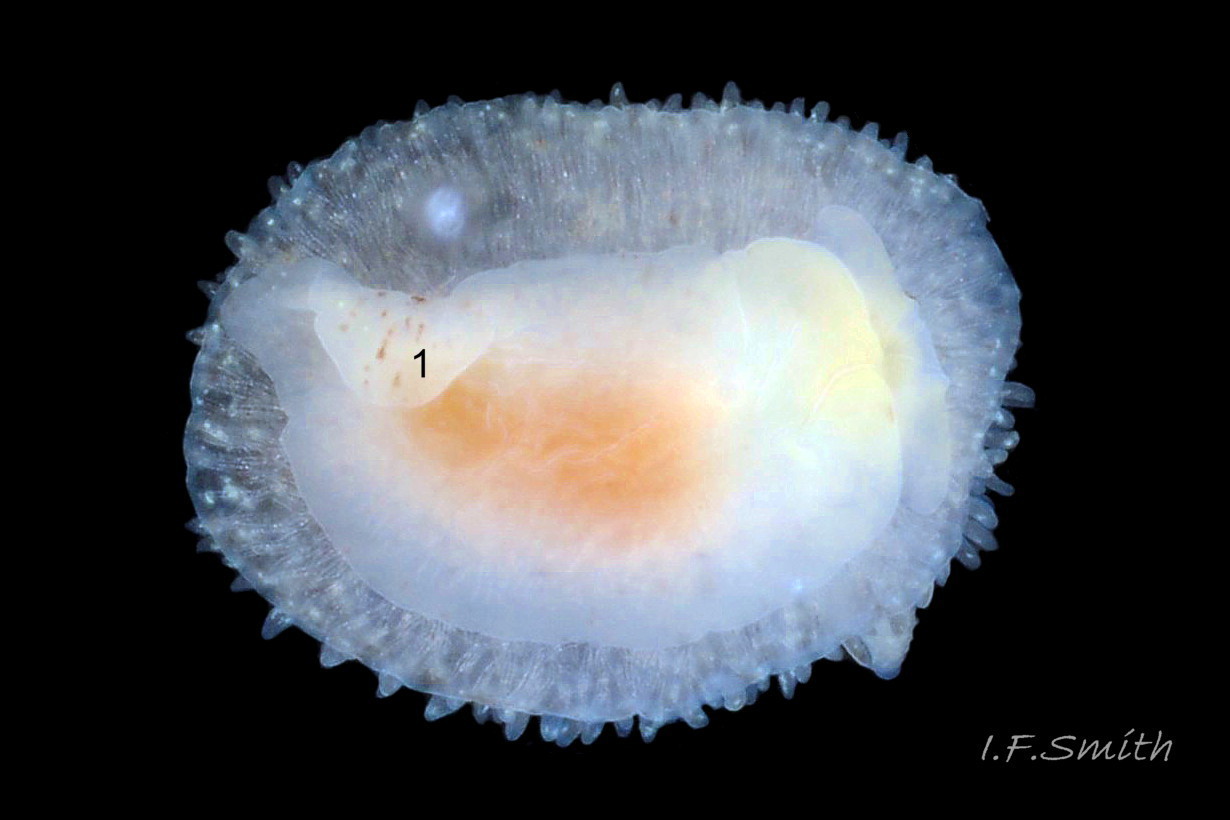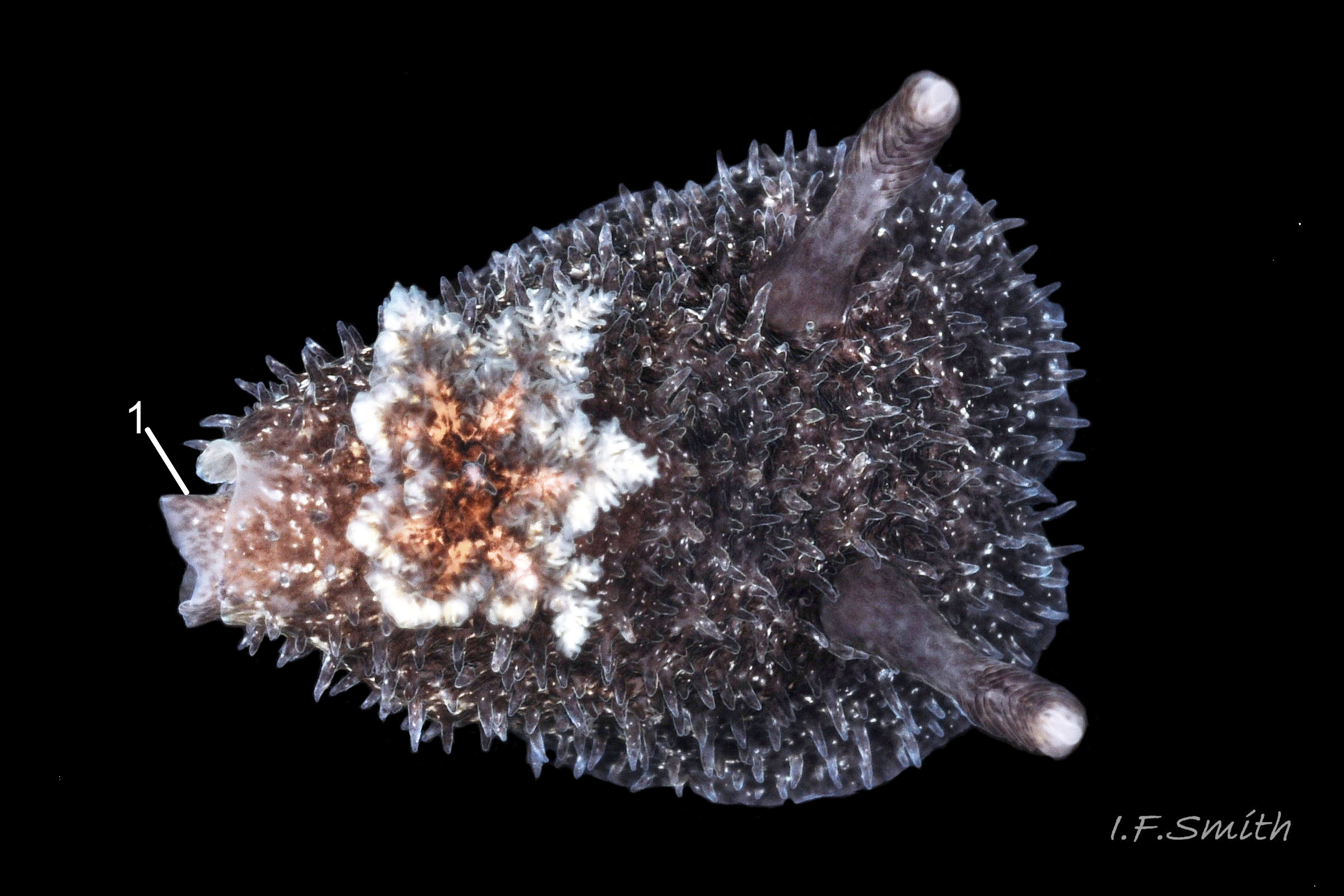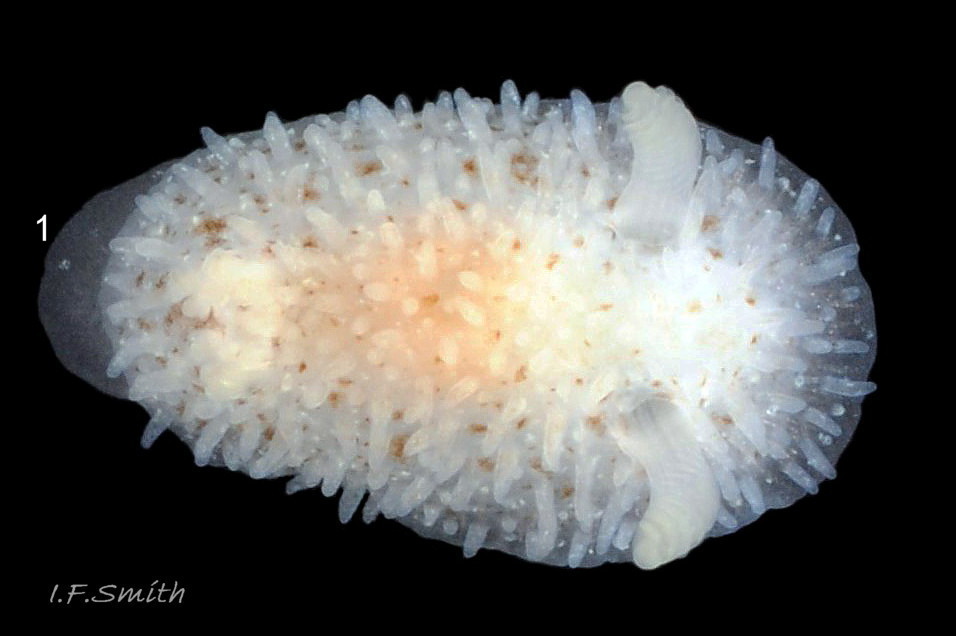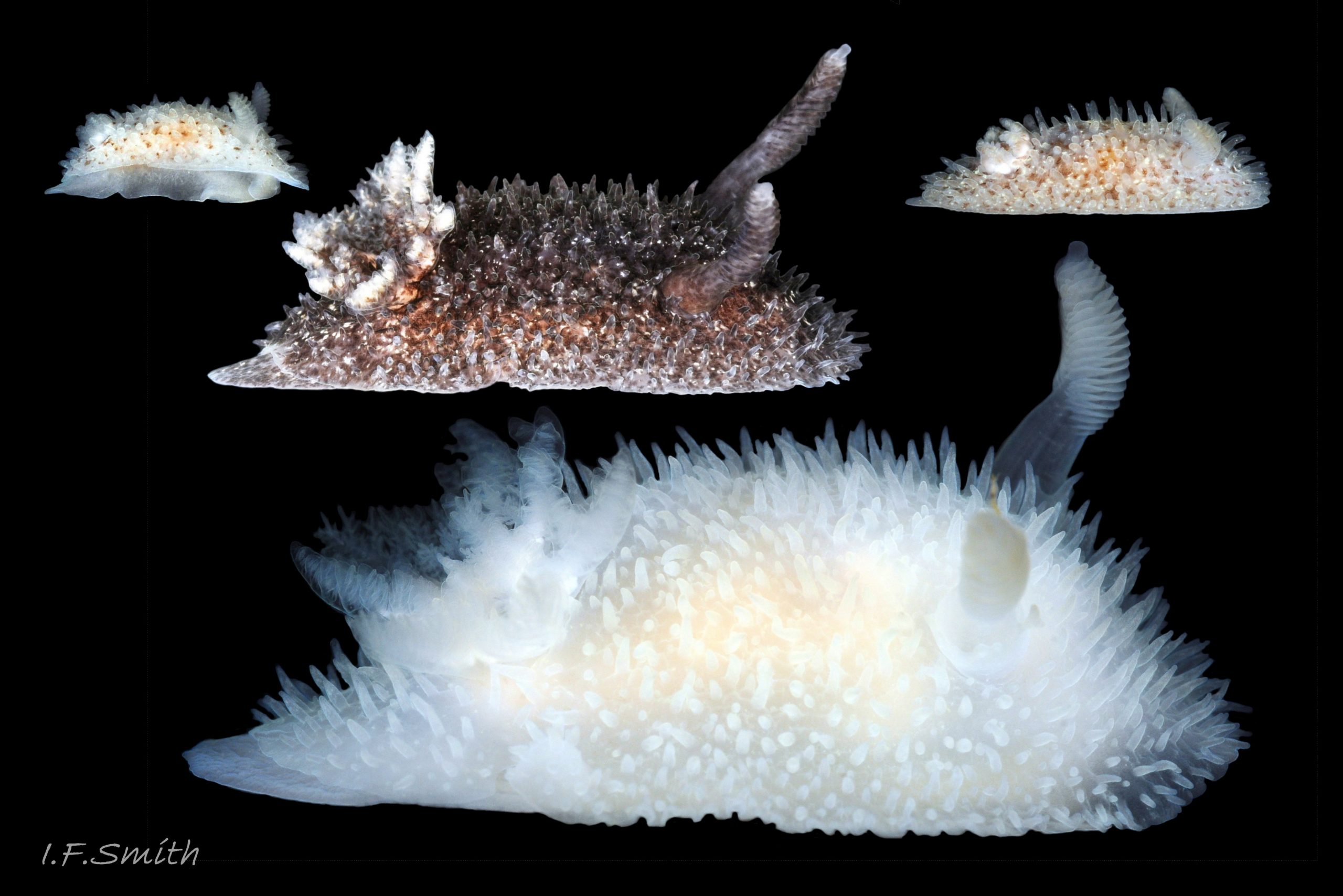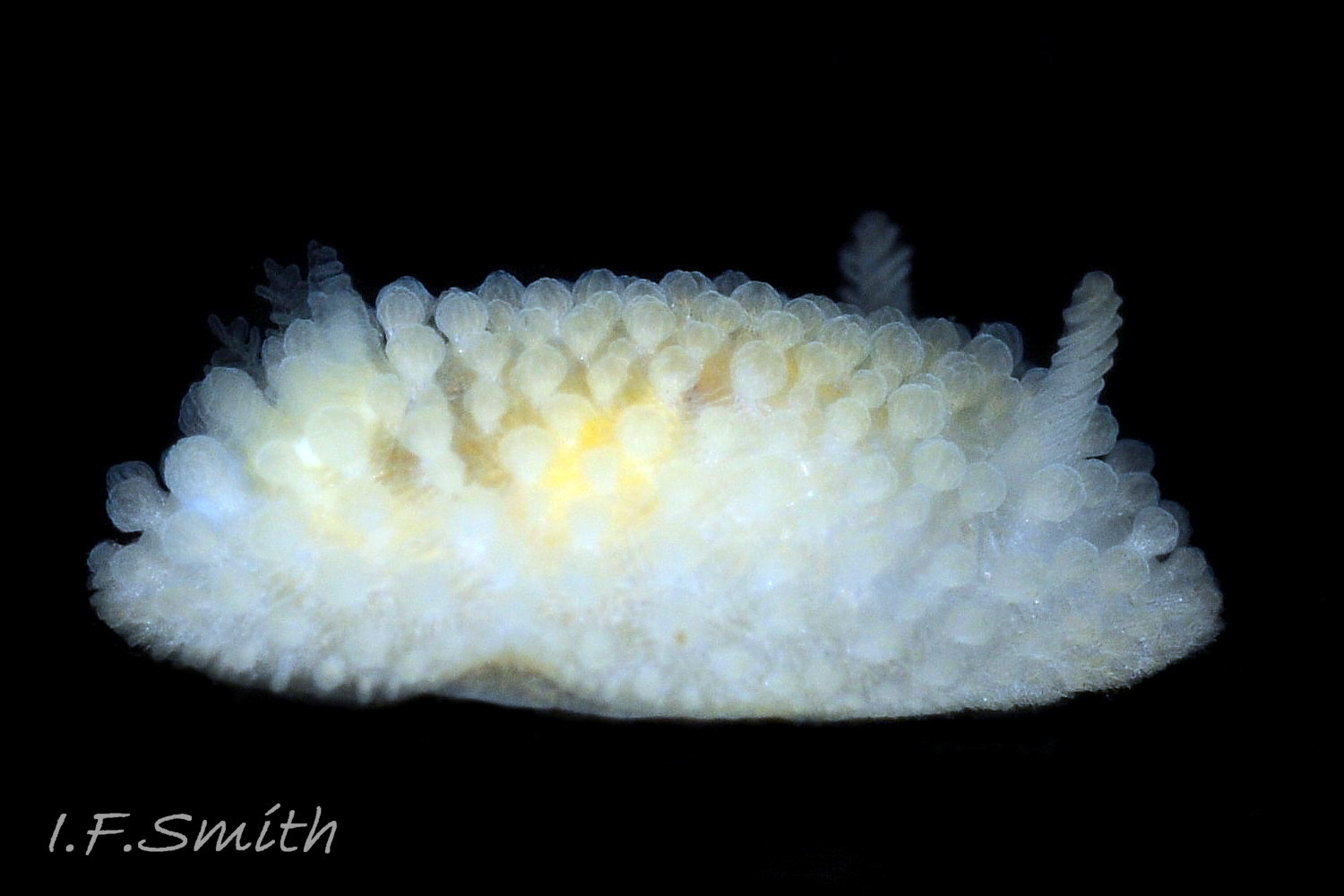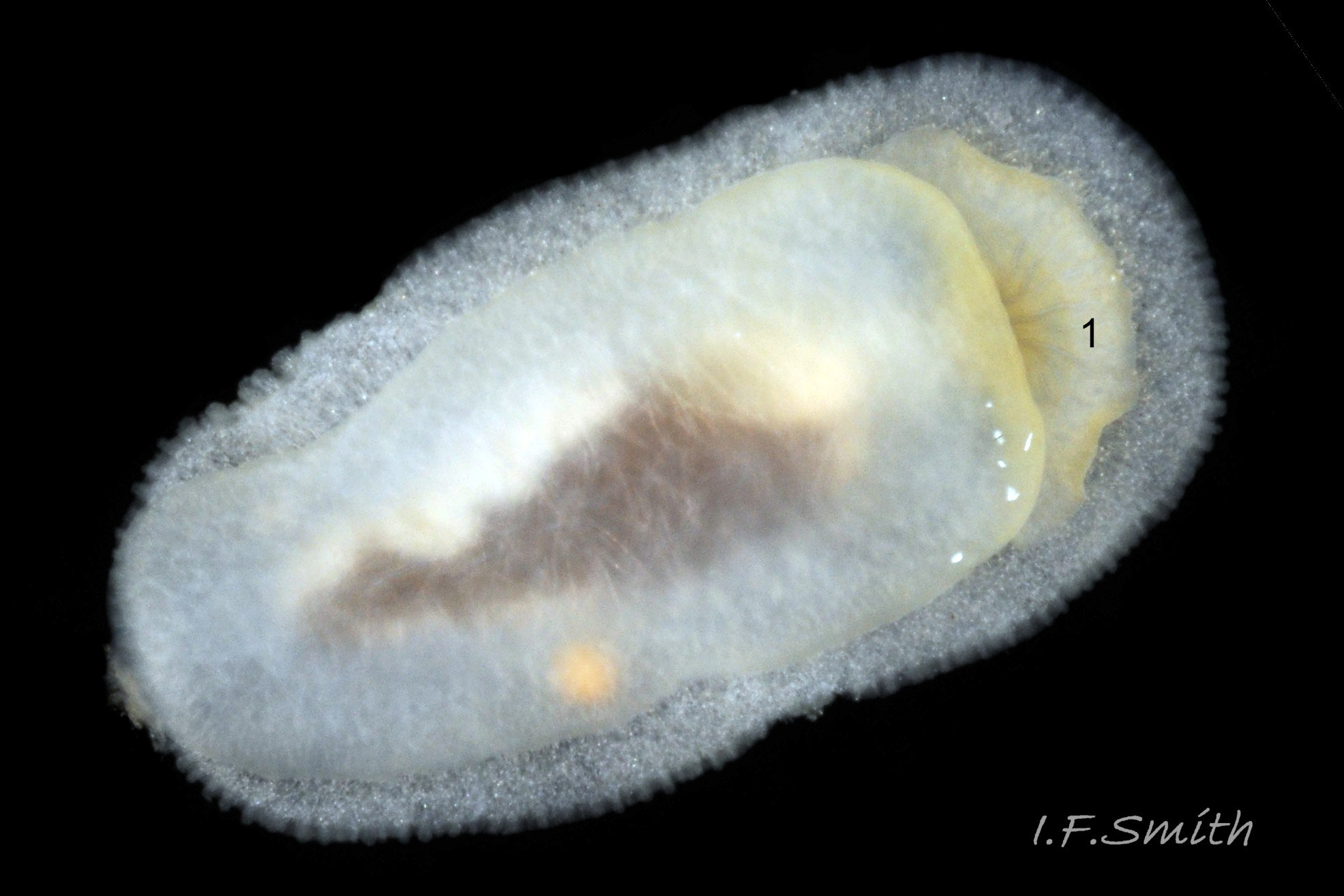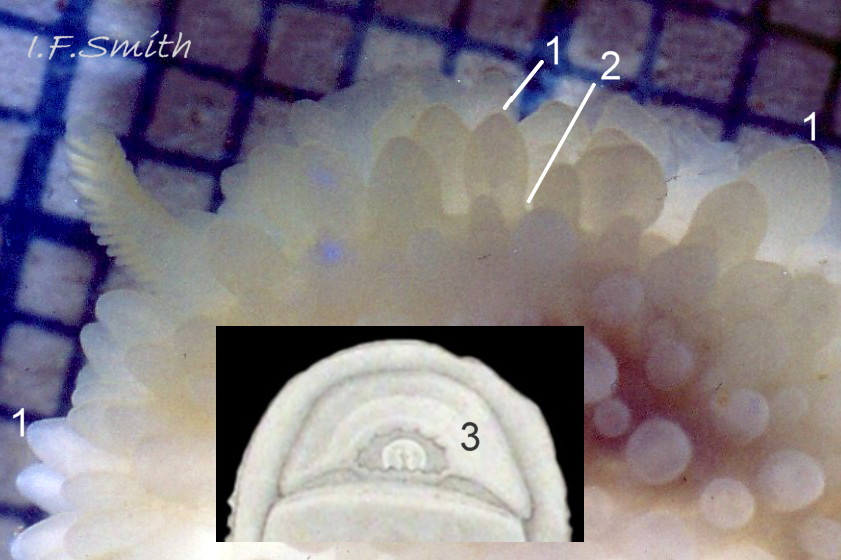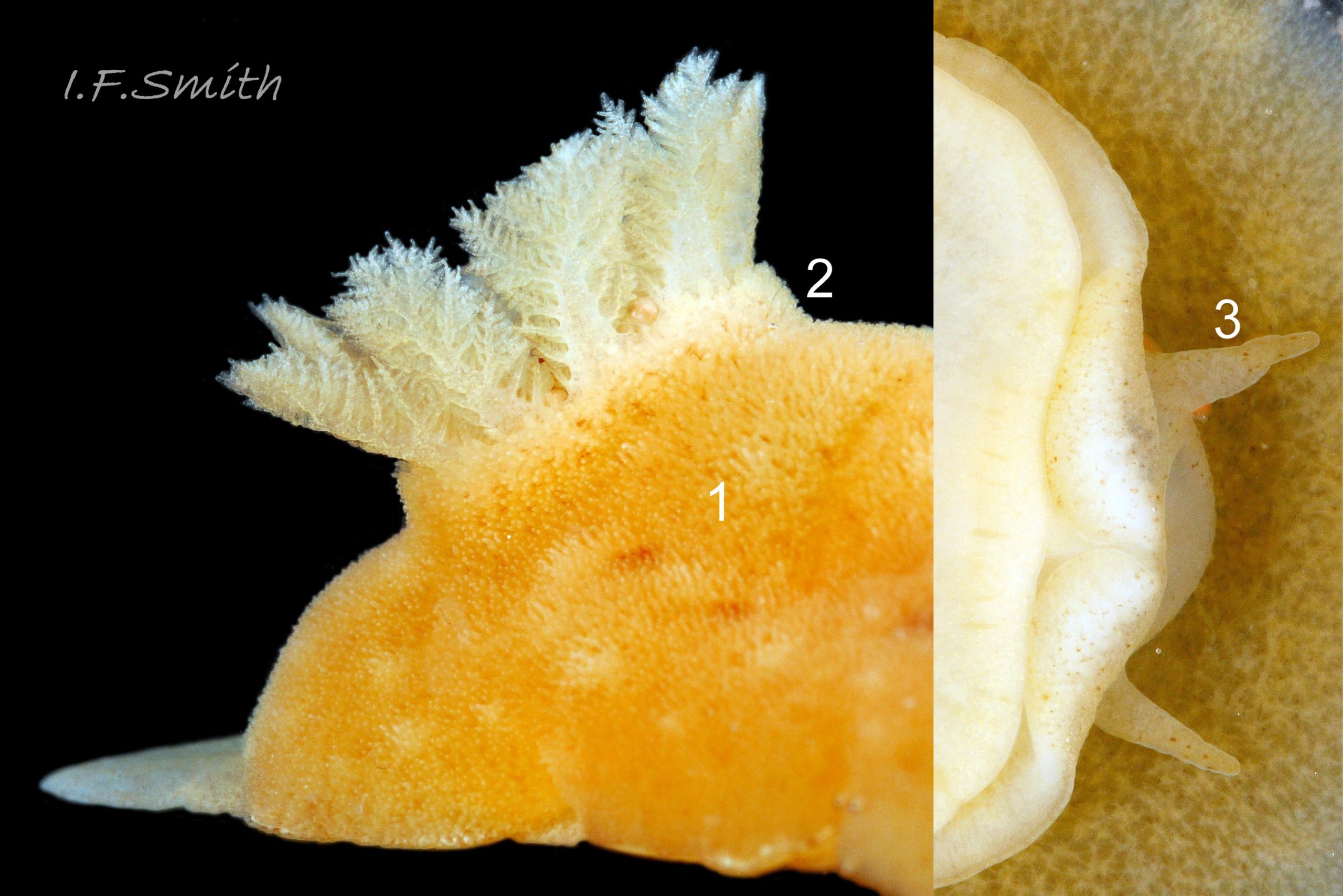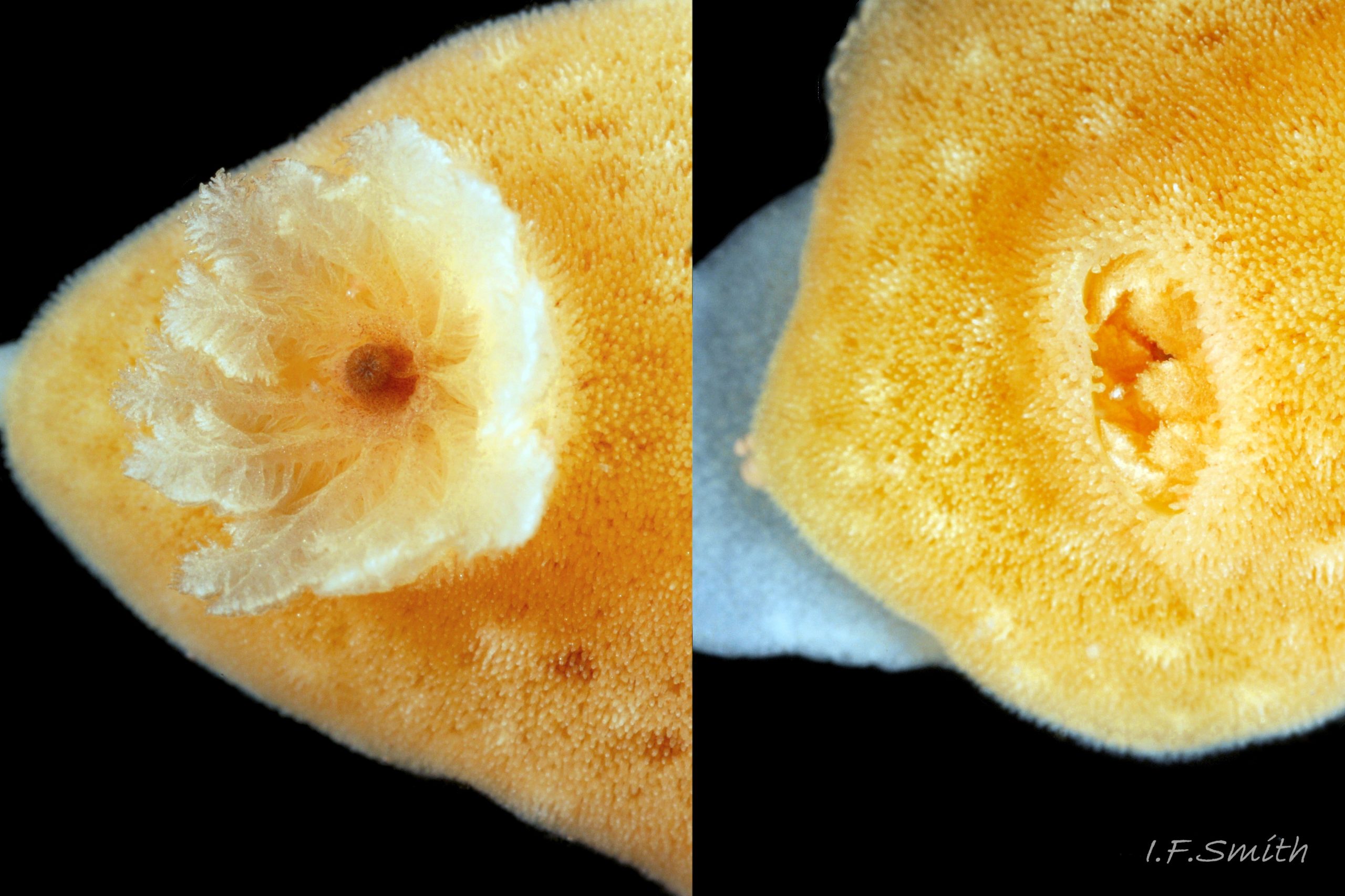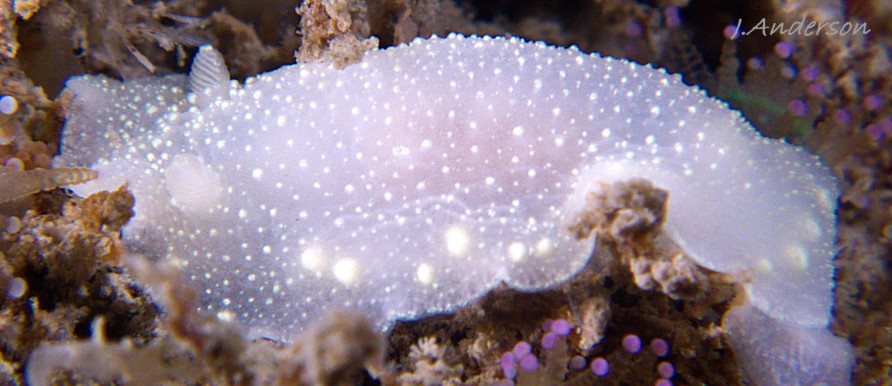Click image to enlarge with full caption. Main text below slider.
Acanthodoris pilosa (Abildgaard in Müller, 1789)
Current taxonomy: World Register of Marine Species (WoRMS) www.marinespecies.org/aphia.php?p=taxdetails&id=140627
Synonyms: Doris pilosa Abildgaard in Müller, 1789 ; Doris subquadrata Alder & Hancock, 1845; Acanthodoris subquadrata (Alder & Hancock, 1845);
Meaning of name:
Acanthodoris = (Greek akantha )Thorny + Doris (name of a sea nymph).
pilosa (Latin) = pilose / hairy / furry / shaggy
GLOSSARY below.
Body
Up to 40mm long, exceptionally 55mm; high dome profile. Mantle covers whole body; varies white 01 Acanthodoris pilosa , brown 02 Acanthodoris pilosa , black,or yellow (P.Lightfoot) flic.kr/p/oJLWhQ . Pale colours may be mottled or freckled darker, especially on juveniles 03 Acanthodoris pilosa. . Translucent pale forms usually reveal pale brown/ yellowish orange viscera 04 Acanthodoris pilosa . Long, fine, radially arranged spicules often visible in mantle when viewed from below 05 Acanthodoris pilosa. ; do not interlock, so body soft and yielding. Soft, tall, thin, conical tubercles on mantle 06 Acanthodoris pilosa. give shaggy/ pilose appearance 04 Acanthodoris pilosa , but sometimes can be somewhat contracted and less distinctive (J.Anderson) Acanthodoris pilosa . Alder & Hancock mistakenly based a separate species, Doris subquadrata 1845, on a single specimen with small conical tubercles www.biodiversitylibrary.org/item/131598#page/158/mode/1up
Rhinophores
Long, rising from low sheath with tuberculated rim; base smooth, upper lamellated part often bent backwards 07 Acanthodoris pilosa. Approximate number of lamellae on one rhinophore at different body lengths: 10 at 4.4mm, 13 at 6mm, 18 at 11mm, 21 at 17mm, 24 at 30mm; numbers include apical ‘nipple’ which is lamellae held upwards. Left and right lamellae meet at anterior groove and as posterior ‘V’ 08 Acanthodoris pilosa . Translucent, usually coloured as mantle, lamellae of white specimens often slightly cream yellow 04 Acanthodoris pilosa , occasionally bright orange (K.G.Pedersen) Acanthodoris pilosa . Rhinophores often held obliquely sideways 09 Acanthodoris pilosa .
Gills
Up to nine voluminous tripinnate gills in circle around anus 04 Acanthodoris pilosa. , 10 Acanthodoris pilosa & 11 Acanthodoris pilosa. Usually translucent and tinted as mantle, with some opaque white along each side of midrib forming a star; sometimes opaque white on lamellae. When disturbed, gills contract separately down to mantle surface 03 Acanthodoris pilosa ; do not retract in unison into a pocket.
Head
Narrow oral veil extended laterally into broad, flat oral tentacles[4]. Anterior of veil has two protrusions centrally 12 Acanthodoris pilosa.
Foot
Sole translucent white, showing opaque whitish gonads 13 Acanthodoris pilosa. or pale brown 05 Acanthodoris pilosa or brownish orange 15 Acanthodoris pilosa viscera centrally . Sometimes a few dark pigment marks on sole 12 Acanthodoris pilosa. Dorsal surface of foot similar to mantle; whitish 1 14 Acanthodoris pilosa freckled sparsely 15 Acanthodoris pilosa or freckled densely 16 Acanthodoris pilosa. Anterior and posterior of foot smoothly rounded 13 Acanthodoris pilosa ; posterior protrudes beyond mantle when in motion 01 Acanthodoris pilosa & 17 Acanthodoris pilosa. Locomotion by monotaxic retrograde waves on sole.
Key identification features
Acanthodoris pilosa
1: Soft, tall, thin, conical tubercles on mantle 06 Acanthodoris pilosa , but sometimes contracted/ poorly developed and not so distinctive (J.Anderson) Acanthodoris pilosa.
2: Body soft and yielding. Usual maximum length 40mm.
3: Voluminous tripinnate gills can contract but not retract into pocket; usually, opaque white along each side of midribs forms a star when gills expanded 04 Acanthodoris pilosa.
4: Narrow oral veil extended laterally into broad, flat oral tentacles. Anterior of veil has two protrusions centrally. 12 Acanthodoris pilosa
5: Upper lamellated part of large rhinophores often bent backwards 07 Acanthodoris pilosa .
Similar species
No other British dorid species has long soft conical tubercles, such large, often bent, rhinophores or its distinctive oral veil/flat oral tentacles, but specimens with contracted or poorly developed tubercles sometimes confused with other white or brownish dorids such as
Onchidoris muricata (O.F.Müller, 1776) :
1: Tubercles shaped as club with flat/slightly rounded tip 19 Acanthodoris pilosa .
2: Body quite firm with many spicules. Usual maximum length 14mm.
3: Simply pinnate small gills can retract into a pocket.
4: Broad rounded oral veil 20 Acanthodoris pilosa .
Onchidoris proxima (Alder & Hancock, 1854)
1: Tubercles, torpedo shaped club with rounded point 21 Acanthodoris pilosa .
2: Body quite firm with many spicules. Usual maximum length 17mm.
3: Simply pinnate small gills can retract into a pocket.
4: Broad rounded oral veil 21 Acanthodoris pilosa.
Jorunna tomentosa (Cuvier, 1804)
1: Fine spiculose tubercles on mantle, “caryophyllidia” 22 Acanthodoris pilosa , under microscope somewhat resembling a clove (spice) in structure.
2: Body spiculate, fairly firm. Usual maximum length 60mm.
3. Expanded gills on raised collar 22 Acanthodoris pilosa album around brown anus 23 Acanthodoris pilosa . Gills can retract into pocket.
4: Head has small tentacles and no veil 22 Acanthodoris pilosa .
Cadlina laevis (Linnaeus, 1767)
1: Unobtrusive, very small, soft tubercles on mantle (J.Anderson) flic.kr/p/6e53ZS
2: Body has soft texture, a flattened low profile, is shiny white with opaque yellow or white marks near the periphery and, sometimes, has an opaque yellow or white peripheral border. Usual maximum length 32mm.
3: Gills not voluminous, hidden much of the time retracted into pocket.(J.Anderson) flic.kr/p/6e53ZS
4: Head has very small tentacles and no veil.
Habits and ecology
On mid- and lower-shore and sublittorally to about 170m.
Feeds on Alcyonidium hirsutumwww.habitas.org.uk/marinelife/species.asp?item=Y1390 on shore, Alcyonidium diaphanumwww.habitas.org.uk/marinelife/species.asp?item=Y1370 sublittorally, and occasionally on Flustrellidra hispida www.unterwasser-welt-ostsee.de/html/rotdorniges_moostierc… . Breeds when 8mm long and larger. Simultaneous hermaphrodite. Spawn (J.Anderson) Acanthodoris pilosa a convoluted ribbon attached by its edge, deposited in spiral of about two turns. Spawning in all months with maximum in spring (when adults commonest 18 Acanthodoris pilosa ) and secondary peak in autumn. Planktonic veliger larvae for about ten days at 10ºC before metamorphosis.
Distribution and status
Iceland to Morocco and western Baltic. Greenland to Virginea, and Alaska to Vancouver. Not within Arctic circle, rare in Mediterranean. GBIF map www.gbif.org/species/2292107 Common and widespread round Britain and Ireland. NBN UK map species.nbnatlas.org/species/NHMSYS0021056240
Acknowledgements
I would like to acknowledge and thank Paula Lightfoot, Jim Anderson and Kjetil Pedersen whose greatly valued images have been linked to this account. Jim’s exceptionally good website and Flickr Albums can be seen at
www.nudibranch.org/Scottish%20Nudibranchs/
and www.flickr.com/photos/jim-anderson/albums
Links and references
Alder, J. & Hancock, A. 1845-1855. A monograph of the British nudibranchiate mollusca. London, Ray Society. www.biodiversitylibrary.org/item/131598#page/152/mode/1up &
www.biodiversitylibrary.org/item/131598#page/158/mode/1up
Catteneo Vietti, R., Angelini, S., Gaggero, L. & Lucchetti, G. 1995. Mineral composition of nudibranch spicules. J. Mollus. Stud. 61 (3): 331-337. Abstract at mollus.oxfordjournals.org/content/61/3/331.abstract
Picton, B.E. & Morrow, C.C. Encyclopedia of marine life of Britain and Ireland. [For prey]. www.habitas.org.uk/marinelife/index.html
Thompson, T.E. & Brown, G.H. 1984. Biology of opisthobranch molluscs 2. London, Ray Society.
Glossary
cephalic (adj.) = of or on the head.
ELWS = extreme low water spring tide (usually near March and September equinoxes).
lamellae (sing. lamella) = small plates on rhinophores, or leaflets of gill.
mantle (of nudibranchs) = sheet of tissue forming part or all of notum (dorsal body surface).
monotaxic (of locomotion waves on foot) = single series of waves across complete width of foot.
myoglobin = red oxygen-binding protein in muscle tissue; often in buccal-mass muscles of gastropods. Similar to red haemoglobin in vertebrate blood, but green haemocyanin is usual oxygen-carrier in mollusc blood. See www.researchgate.net/publication/251227038_Radular_myoglo…
papilla = (pl. papillae) small cone-shaped protrusion of flesh.
papillate = covered in papillae.
plankton = animals and plants that drift in pelagic zone (main body of water).
retrograde (of locomotion waves on foot) = waves travel from anterior to posterior.
rhinophores (pl.) = chemo-receptor tentacles on top of head of nudibranch.
tripinnate (of gill plume) = threefold branching; “boughs, branches, twigs” in one plane like a feather.
spicule (in dorid seaslugs) = small, slender, sharp-pointed feature mainly composed of calcite (CaCO3) and brucite (Mg(OH)2) .
spiculate = containing spicules.
veliger = shelled larva of marine gastropod or bivalve mollusc which swims by beating cilia of a velum (bilobed flap).
